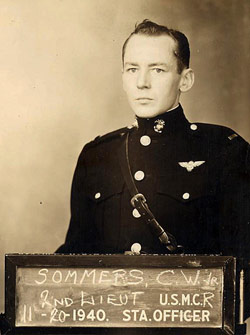Life of Brewster Pilot is Reminder of Courage during Battle of Midway

Col. Charles Somers, Jr. as a Marine Second Lieutenant at the time he returned from the fleet and reported to Naval Air Station as a flight instructor. Photo Courtesy of the Naval Aviation Museum Pensacola, FL
The Battle of Midway (June 4-7, 1942) is considered the most decisive U.S. victory of World War II and is referred to as the turning point of the war in the Pacific. During this early era of air combat, what American aviators lacked in technology, they made up for in skill and bravery.
In February of 1942 – mere months before the famous battle – a Brewster F2A-3 Buffalo made an emergency water landing during a squall in the lagoon at Midway Atoll, now a National Wildlife Refuge and part of Papahānaumokuākea Marine National Monument.
This discovery of that plane at Midway in the summer of 2012 led to clues that reveal the remarkable story of its pilot, Lt. Col. Charles W. Somers, Jr., who survived the crash and went on to have a distinguished career as a U.S. Marine Corps aviator.
Outmatched by the far superior Japanese Zero aircraft, the U.S. squadrons knew the odds were against them as they entered into air combat flying the less maneuverable Brewster Buffalo, an aircraft commonly referred to as the "flying coffin." Of the 19 Brewsters that took off from Eastern Island during the Battle of Midway, only four returned and of those, only two were operable.

Col. Charles Somers (second from right) at Palmyra Atoll September 17, 1942. Photo Courtesy of John Powell

Brewster F2A-3 fighter in flight, piloted by LCdr. Joseph C. Clifton, August 1942. Photo courtesy of National Archives and Records Administration
The Brewster F2A-3 Buffalo was part of VMF-221, the Marine Aviation Squadron based at Midway Atoll during WW2 and the Battle of Midway. Of the two Brewsters that were reported down near Midway, the plane discovered in 2012 was determined by its specific location to have been captained by Col. Somers. Oddly, his landing in the lagoon at Midway may have been fortuitous; shortly after the crash, he spent time on Oʻahu to recover from an illness and therefore did not participate in the fateful Battle of Midway.
The Midway aircraft is a somber reminder of the bravery and courage of those WW2 aviators like Charles W. Somers, Jr., who fought for our freedom against great odds during the Battle of Midway. Knowing very well how outmatched they were against the Japanese, these men entered into combat anyway.

PMNM Maritime Heritage Coordinator Kelly Gleason examines landing gear from the sunken aircraft site, checking for identifying markings. Credit: Stephani Gordon/Open Boat Films

PMNM Maritime Heritage Coordinator Kelly Gleason (left) and Bert Ho of the National Park Service Submerged Resources Center (right) examine the sunken aircraft site. Credit: Stephani Gordon/Open Boat Films
On September 13, 2000, Secretary of the Interior Bruce Babbitt designated the lands and waters of Midway Atoll National Wildlife Refuge as the Battle of Midway National Memorial, "so that the heroic courage and sacrifice of those who fought against overwhelming odds to win an incredible victory will never be forgotten." This is the first National Memorial to be designated on a National Wildlife Refuge.

PMNM Maritime Heritage Coordinator Kelly Gleason examines the site. Credit: Stephani Gordon/Open Boat Films

PMNM Maritime Heritage Coordinator Kelly Gleason inspects the tire of the landing gear. Credit: Stephani Gordon/Open Boat Films
The story of Col. Charles W. Somers, Jr. helps to put a face on these men. He was awarded the Distinguished Flying Cross in March of 1942 after he engaged in combat with a Japanese four-engine seaplane, destroying the enemy aircraft. He went on to become one of the first officers attached to VMF-214, the famous Black Sheep Squadron. He also participated in the Korean conflict, and retired as Commandant of the Marine detachment of Pensacola Naval Air Station. Col. Somers died in 1992 and is buried at Barrancas National Cemetery in Pensacola, Florida.
For more information on the Battle of Midway, see our special commemorative site Remembering the Battle of Midway.
For more information on the Brewster Buffalo, see:
- Full Story
- Fact Sheet
- Short film (5:01 minutes)
- TIGHAR article "Lessons From the Buffalo"
- 2012 story about the discovery, with pictures
For more information on the historic and maritime features of the Monument, see:
- Known wreck sites in PMNM map
- Battle of Midway brochure
- Pacific Islands Region Maritime Heritage brochure
- Maritime Heritage
Special thanks to:
